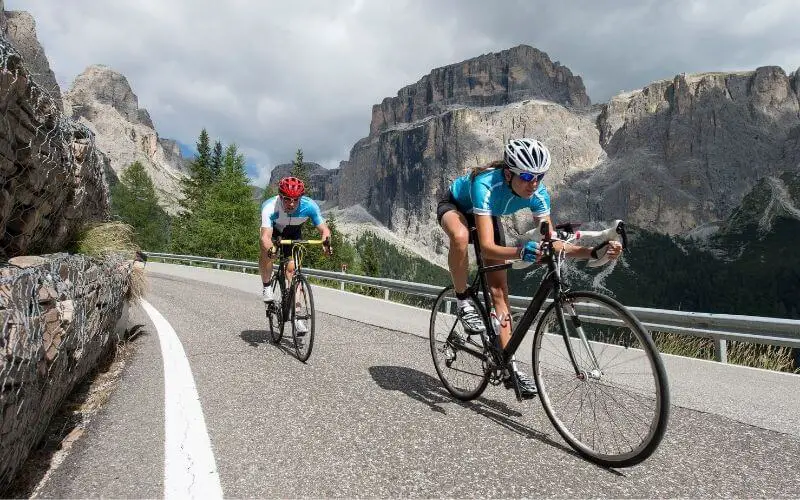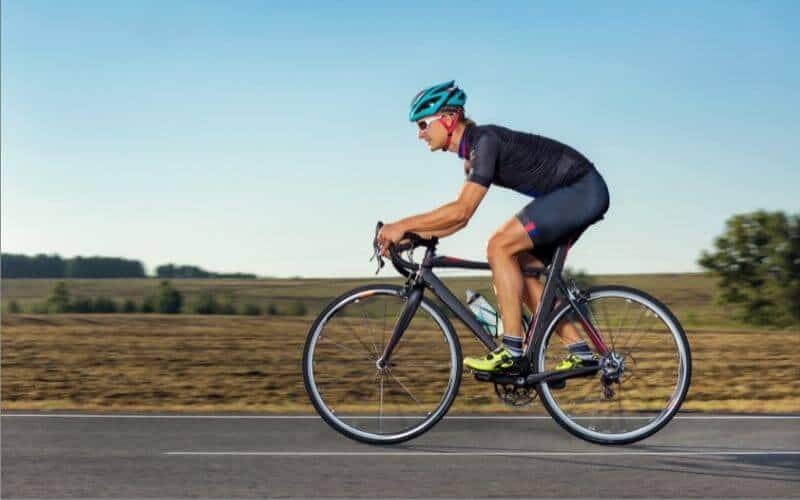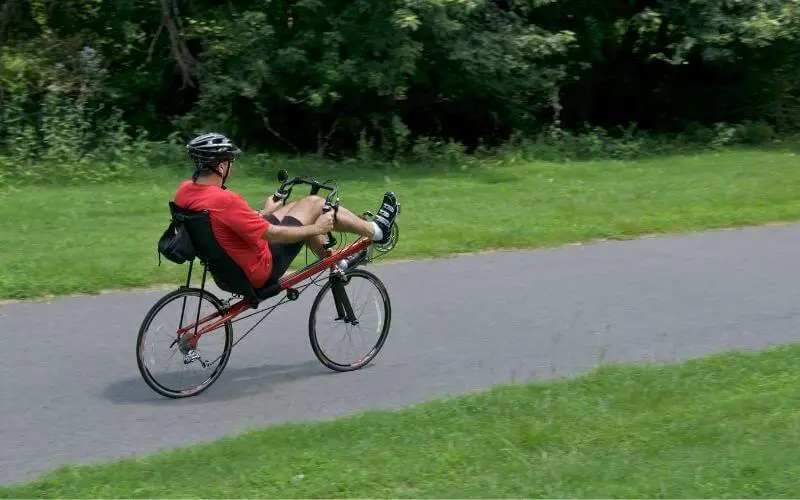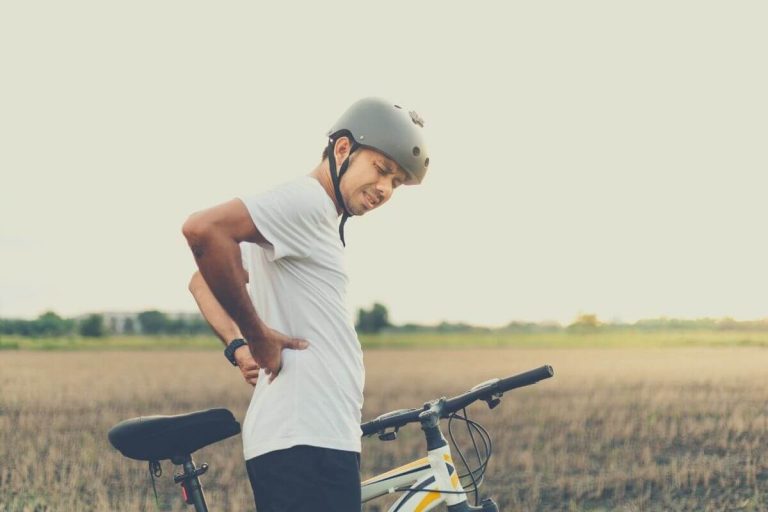So cycling is said to be great for reducing lower back pain by some people. Some people have said it has made things worse. So which is it?
A road bike is good for your back when your bike is set up correctly for your body and you’re riding with a good posture. Providing you don’t have an underlying back problem, cycling should be good for your back, strengthening all the right muscles!
Cycling is a lower impact activity, we can at least all agree on that. We’re going to look at how to get these things right to ensure that cycling has a positive impact on your back and if you are getting issues, then let’s look at what could be the issue! We’ve got solutions too! 😁
Are Road Bikes Good For Your Back?
So the good news is that when ridden properly, riding a bike brings many benefits in that it helps to strengthen and stabilize your back muscles as well as your hips, shoulders, and spine (the gift that keeps on giving, really!).
However, the crucial part of all of that is that it must be done properly. So what does all that mean?
We’re talking about things like posture, bike fit, and various other aspects. All of these must be right to prevent back pain when cycling so let’s drill down into the details!

Riding Posture
If you don’t maintain proper posture when cycling, you can easily strain your back. The drive to become more aero and the ‘slam that stem’ trend doesn’t always consider the needs of your back!
If you can, try to avoid leaning over with your back arched excessively (what excessively means, will vary from each individual so it’s a case of finding your own ‘sweet spot’).
You also want to try to refrain from curving down too much too, especially with your head facing fully forwards – you’re very likely to ache from this! Let your upper body take the impact of riding, rather than your spine. Your arms should always be slightly bent too.
Getting the right saddle height is a major factor also. Your legs shouldn’t fully extend when you’re on the downward stroke, you want a little bend in them. When you’re on the top stroke, your knees should have an angle of no less than 90 degrees as this will be easier on your lower back.
If you’re spending a decent amount of time in the saddle, it’s important to change the angle and position of your torso every now and then. Muscles can stiffen up and get fatigued over time if they’re trying to hold one position so this is a way to combat that.
Related article – Best Road Bikes Under $500 – Budget Friendly Options
Bike Geometry
I don’t think I can stress enough the importance of having the correct bike fit for you. It impacts everything so it’s the one thing you should get right from the get-go.
Though not strictly geometry-related, I will say, ensure you get the right bike for your purpose. If you’re planning on going off-road, don’t get yourself a road bike.
If you’re looking to buy your bike from a brick-and-mortar shop, hit your local bike shop, rather than a general store that just happens to also sell bikes. The advice the guys in your dedicated bike shop can give you is gold dust!
You can find a great selection of bikes online too (here for example), just make sure to pay attention to the measurements of the bike and yourself to ensure that you get the right fit! If the bike is too big for you, you’ll find yourself reaching forward to get to the handlebars, as a result, you’ll be overextending your spine.
On the flip side, if the bike is too small, then you’ll find yourself hunched over. The knock-on effect of that is that you’ll be over-flexing your back and hips.
Related article – Bike Geometry Explained

Alternative Bike Types
Depending on the cause of your back pain, a ‘traditional’ bike may not help your pain but if you love cycling, you shouldn’t let that stop you, there are a few alternatives for you so you can still get out on the road!
You may find that you’ll be more comfortable in an upright position with high and straight handlebars. Another way to significantly reduce shock when you’re riding is to have bigger tires and a suspension. This will reduce the impact on your neck and spine.
Recumbent Bikes
A recumbent bike is specifically designed to give you support for your back. So, if you have underlying back pain, these can be a fantastic way to still being able to cycle, without the risk of damaging your back further.
As the name suggests, you will be lying down or sitting comfortably. This allows your weight to be evenly spread out over a larger area so it takes away the pressure, you’d otherwise feel.
Alright, I’m not going to sugarcoat it, you can look/feel a little odd if you’re not used to this style of bike but you soon get used to it. You’ll be comfortable and your back will thank you for it. Happy days!
Semi-Recumbent and Upright Bikes
Recumbent bikes aren’t for everyone but these days you can get hold of bikes that seat you higher up but still don’t put the same amount of pressure on your back as a road bike will.
Semi-recumbent bikes will do this for you. Comfort-wise, they aren’t on the same level as a recumbent bike but some prefer the higher seated position. What you also find with these bikes is that they feature shock absorption built into the saddle so reducing the pressure further.
Related article – Why Does My Bike Seat Keep Coming Loose?

How To Avoid Lower Back Pain While Cycling
Causes And Prevention
Here are a few reasons why your back is hurting and how you can try to avoid it.
Poor Bike Fit
The most common cause of pain on a bike comes down to the bike fit. I would highly recommend getting a professional bike fit, even if you have to pay for it, it’ll be worth it!
Low Cadence
Mashing on your gears (i.e sitting in a harder gear than needs be) could mean that you’re working your muscles too hard.
Those muscles include those in the lower back and hips. They can quickly become fatigued in this situation and this is when they can become painful.
A higher cadence can usually solve this. Try increasing your cadence to around 80-90rpm. This will make you engage your cardiovascular system more and reduce the pressure on your muscles.
Related article – Cycling Cadence – What Is It And How To Measure It
Increasing Mileage Quickly
This goes for a lot of sports, if you want to go further, you need to do it slowly and build up to longer distances.
When you increase your mileage too quickly, your muscles aren’t conditioned to handle it, most of the time this means your lower back takes the strain.
You need to allow your body to get used to the extra training. Don’t increase your mileage by more than 20% each week.

Tips On How To Reduce Lower Back Pain While Riding
You can do a few things to prevent suffering from lower back pain when you’re cycling. A lot of it is to be done when you’re off the bike.
A flexible spine and hips are key for preventing lower back pain when cycling. You should also look at focusing on strengthening your glute and core muscles to ensure that they can do their job.
So I’m sure you know what’s coming…stretches!
Exercises To Strengthen Core Muscles
Hip Opener and Glute Stretcher
This stretch is all about opening your hips and flexing your glutes.
So you want to start by sitting on a chair. With your left foot on the floor, your calf should be perpendicular to your left thigh. Your left knee and ankle should be in a straight line too.
Now take your right ankle onto your left knee.
Try to keep your spine as long and make it as extended as possible. When you come to inhale, fold at the hips. When you exhale you want to bend your torso forward over your right shin.
When you’re in this position, hold it and take 5 long, deep breaths. Then relax and put your forearms on top of the folded leg.
Swap your legs over and repeat.
Downward Dog
The downward-facing dog is a whole-body stretch, really designed to ease tension in the spine. It will open up your hips and give your legs a stretch too – it’s one of my favorites!
To start, get onto your hands and knees. Your wrists should be in line with your shoulders and your knees under your hips. Tuck your toes!
Now, you want to stretch your arms in front of you, slowly though. Be sure to keep things a shoulder-width apart. Then you can lift a knee from the floor but your toes should be facing forward.
Time to straighten your legs by lifting your bottom. One key thing I’ve picked up is to spread your fingers, this helps to spread your weight evenly.
Once you’re in this position, hold it for around 15 seconds.
Supine Body Movement
For those of you who have a stiff back then this one is for you.
This stretch is all about releasing the tension built up in your spine, shoulders, and hips.
Lie on your back and bend your knees, bringing them close to your chest. It should be like you’re sitting on a chair.
Then you want to slowly bring your knees to the floor on your right. As you’re doing this, twist your torso but keep your upper back firmly and flush to the floor.
What you should find is that your face and shoulders are facing up, even when your knees are swiveled to the right.
Something you may find is that you can’t quite reach the floor yet, if that’s the case, just rest your knees on a pillow.
Then spread your arm out and count to five. Return your knees forward and repeat the process on the left side.
Hug Stretch
The hug stretch is designed to be felt in the shoulders and upper back.
Look straight ahead, while making sure your back is straight and your neck.
Take your arms and cross them around your shoulders. Basically, as if you’re giving yourself a hug.
I need you to give yourself a really big hug, try to reach the center of your back. If you can get between your shoulder blades, you’re doing it right!
What this will do is compress your chest inwards and your back will be curved outwards slightly. This stretch should be held for around 5 seconds before switching.
Katie Kookaburra does a great job of summing up a selection of stretches for cyclists! The good news is that she understands we cyclists don’t want to spend ages stretching, so this routine is short but hits all the right places!
Here are a few of the best stretches for cyclists to help recover faster.
Other Areas Of Discomfort [Cause And Prevention]
Neck Pain
Another one of the most common complaints from cyclists (myself included!).
Neck pain is usually fixable. It usually comes from being in an uncomfortable place for a long time, i.e a road bike!
To prevent this, you want to ensure your position is beneficial to your neck.
This video gives some seriously good advice!
Middle Back Pain
Though not as common as other areas of pain, middle back pain can be caused by a lack of muscle strength and the only way to fix this is to increase your muscle!
For this, I’d recommend either stretches or other exercises, a rowing machine is fantastic for this!
Knees
Knees are a super common pain point for cyclists. It comes down to the motion when you’re pedaling and if anything is slightly out of line, you’re going to get issues.
The cause of knee pain will depend on where the pain is in the knee. Is it at the front, back, or inside?
Bike fitting expert Neil Stanbury addresses all of the possible causes:
Related article – Is Running Or Cycling Worse For Your Knees?
Final Thoughts
Road bikes are good for your back (and just about every other part of your body!). If you’re experiencing difficulties then it could be worth seeking professional advice to get those niggles addressed.
Ask yourself…how often do you stretch?

